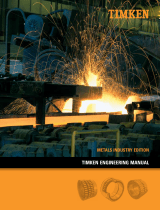Page is loading ...

An O-ring is a solid-rubber seal shaped like a
doughnut or torus. When compressed between
mating surfaces, an O-ring blocks the passage of
liquids or gases. Parco O-rings are available in a
wide range of standard and non-standard sizes
that are suitable for nearly all sealing
applications.
Two dimensions describe the size of an O-ring: its
inside diameter (ID) and its cross-sectional
diameter (CS) (see Figure 1).
Understanding O-ring Sizes
and Tolerances
Standard Sizes
The standard sizes used by Parco and the other
major O-ring manufacturers in the United States
are defined by Aerospace Standard AS568B,
Aerospace Size Standard for O-rings. That
document, published by the Society of
Automotive Engineers (SAE), lists the sizes of
O-rings in six series or groups in both inches and
millimeters. The first five series are based on
cross-sectional diameter. The sixth series includes
20 sizes for boss seals. The standard sizes are also
used for most military specifications.
Cross-sectional diameters range from 0.040 to
0.275 inch. Inside diameters range from 0.029 to
25.940 inches. Parco also has hundreds of molds
for non-standard sizes. Parco offers O-rings in all
369 standard sizes, shown on the enclosed chart.
Metric Sizes
Standard metric sizes for O-rings are defined by
International Standard ISO 3601-1:2002: Fluid
power systems—O-rings—Part 1: Inside
diameters, cross-sections, tolerances and size
identification code. That standard groups metric
sizes into two series, G and A.
The G series is used for general purpose
applications and includes a wide range of inside
diameters. The A series is used for aerospace
applications where tighter tolerances are
recommended. The G series has 445 sizes and the
the A series has 383 sizes.
The International Organization for
Standardization issued ISO 3601-1 in 1978 and
revised it in 1988 and 2002. Another major
revision is being developed to bring ISO sizes in
line with the sizes in Aerospace Standard
AS568B. Currently, ISO sizes do not use a dash
numbering system like the Aerospace Standard.
ISO cross-sectional diameters differ from the
Aerospace Standard by less than 0.001 inch.
Therefore, many AS568B sizes are interchange-
able with an ISO size. Be sure to consult ISO
3601-1 for specific dimensions, as inside
diameters may differ.
If Parco does not have a mold for a non-standard
size or a particular ISO size, we can make one for
you.

Dimensional Tolerances
The tolerances of AS568B, introduced in 2001,
are a combination of the former Class I and Class
II tolerances of AS568. Below is a brief history of
that standard.
In 1958, the SAE issued Aerospace Recommended
Practice ARP568, Uniform Dash Numbering
System for O-rings. In 1971, the SAE replaced
ARP568 with Aerospace Standard AS568. AS568
called for two classes of tolerances for inside
diameters. Class II was for O-rings made of
higher-shrinkage elastomers, such as
fluorocarbon and fluorosilicone. Class I was for
O-rings made of other elastomers. Class II
permitted wider tolerances than Class I.
O-ring sealing is based on the volume
relationship between the O-ring and the gland.
Slightly wider dimensional tolerances, especially
for larger diameter O-rings, make no significant
difference in the O-ring volume. Therefore, seals
made to Class II tolerances have proved as
effective as seals made to Class I tolerances.
For that reason, Aerospace Standard AS568A
used a single set of tolerances for inside
diameters. For O-rings with IDs less than 0.5 inch,
AS568A used the former Class I tolerances. For
larger O-rings, AS568A used the Class II
tolerances. In 2001, AS568B was issued to
modernize the scope and notes of the standard
without affecting the dimensions, tolerances, or
dash numbers.
The tolerances from AS568B are being
incorporated into all U.S. military specifications
and drawings as they are revised. In the future,
we expect most AN, MS, and NAS tolerances to
match AS568B. Also, many companies have
revised their own standards to match AS568B.
Choosing the Correct
Cross-Sectional Diameter
You may choose O-rings from several standard
cross-sectional diameters for your application.
For all applications, O-rings with a larger cross-
sectional diameter tend to have better resistance
to compression set. They also have less volume
swell in fluids and are less likely to leak if their
surface is scratched. O-rings with smaller cross-
sectional diameters have better physical
properties, are more resistant to explosive
decompression, and require less space.
For many dynamic applications, there is some
choice of cross-sectional diameters. Larger cross-
sectional diameters are more resistant to rolling
in a groove but have more friction. For
reciprocating applications, O-rings with small
cross-sectional diameters have less friction but
tend to slide and roll in a groove. This can lead
to leaks caused by spiral failure of the O-ring.
In general, tighter tolerance components or rigid
components with smooth or ground surface
finishes can use O-rings with the smallest cross-
sectional diameter regardless of the pressure.
Parts with looser tolerances or less rigid
components, such as large plastic housings,
should use O-rings with larger cross-sectional
diameters. Those plastic housings could flex
under high pressure or expand when heated,
reducing the actual squeeze on the seal.
O-rings with smaller cross-sectional
diameters have better physical properties,
are more resistant to explosive
decompression, and require less space.
/



